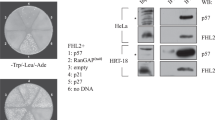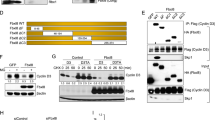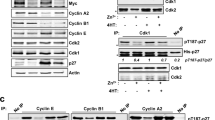Abstract
Coordinated accumulation of cyclin D1 and D3 is observed in 15% of primary breast cancers and in the breast cancer cell line MCF-7 this simultaneous overexpression is due to a defect in their ubiquitin-mediated proteolysis. The F-box protein Skp2 is a component of an SCF ubiquitin ligase complex and can associate with cyclin D1 and the cdk inhibitor p21 (Zhong-Kang et al., 1998). We extend this observation and show that cyclin D3 can also associate with Skp2 suggesting that cyclins D1, D3 and p21 may share the same SCF complex. In agreement with this hypothesis we report here that in primary breast cancers and in MCF-7 cells where cyclins D1 and D3 are elevated the level of p21 is also elevated. Further, we demonstrate that the turnover of p21 protein is reduced in MCF-7 cells. We show that p21 is active as a cdk inhibitor in this cell line but that the presence of elevated levels of cyclin D3 titrates p21 away from cyclin D1-cdk4/6 complexes and cdk2 complexes resulting in increased kinase activities. Our results suggest that a defect in the SCF complex may occur in 15 – 20% of breast cancers and that the resulting coordinated elevation of cyclins D1 and D3 overcomes the inhibition of cell cycle progression by p21. We propose that in the context of cyclins D1 and D3 overexpression, p21 may promote cell cycle progression.
This is a preview of subscription content, access via your institution
Access options
Subscribe to this journal
Receive 50 print issues and online access
$259.00 per year
only $5.18 per issue
Buy this article
- Purchase on Springer Link
- Instant access to full article PDF
Prices may be subject to local taxes which are calculated during checkout






Similar content being viewed by others
References
Ando K, Ajchenbaum-Cymbalista F and Griffin JD. . 1993 Proc. Natl. Acad. Sci. USA 90: 9571–9575.
Bartkova J, Lukas J, Strauss M and Bartek J. . 1998 Oncogene 17: 1027–1037.
Bartkova J, Zemanova M and Bartek J. . 1996 Int. J. Cancer 65: 323–327.
Cheng M, Olivier P, Diehl JA, Fero M, Roussel MF, Roberts JM and Sherr CJ. . 1999 EMBO J. 18: 1571–1583.
Diehl JA, Cheng M, Roussel MF and Sherr CJ. . 1998 Genes. Dev 12: 3499–3511.
Diehl JA, Zindy F and Sherr CJ. . 1997 Genes Dev 11: 957–972.
Gillett C, Fantl V, Smith R, Fisher C, Bartek J, Dickson C, Barnes D and Peters G. . 1994 Cancer Res. 54: 1812–1817.
Helin K. . 1998 Curr. Opin. Gen. Dev. 8: 28–35.
Krek W. . 1998 Curr. Opin. Gen. Dev. 8: 36–42.
LaBaer J, Garrett MD, Stevenson LF, Slingerland JM, Sandhu C, Chou HS, Fattaey A and Harlow E. . 1997 Genes Dev. 11: 847–862.
Lukas J, Bartkova J and Bartek J. . 1996 Mol. Cell. Biol. 16: 6917–6925.
Maki CG and Howley PM. . 1997 Mol. Cell. Biol 17: 355–363.
Matsushime H, Quelle DE, Shurtleff SA, Shibuya M, Sherr CJ and Kato J-Y. . 1994 Mol. Cell. Biol. 14: 2066–2076.
Morgan DO. . 1995 Nature 374: 131–134.
Musgrove EA, Lee CSL, Buckley MF and Sutherland RL. . 1994 Proc. Natl. Acad. Sci. USA 91: 8022–8026.
Patton EE, Willems AR and Tyers M. . 1998 Trends Genet. 14: 236–243.
Rey MJ, Fernandez PL, Jares P, Munoz M, Nadal A, Peiro N, Nayach I, et al. 1998 J. Path. 184: 265–271.
Russell A, Thompson AM, Hendley J, Trute L, Armes J and Germain D. . 1999 Oncogene 18: 1983–1991.
Sheikh MS, Rochefort H and Garcia M. . 1995 Oncogene 11: 1899–1905.
Sherr CJ and Roberts JM. . 1995 Genes and Development 9: 1149–1163.
Skowyra D, Craig KL, Tyers M, Elledge SJ and Harper JW. . 1997 Cell 91: 209–219.
Wang T, Cardiff RD, Zukerberg L, Lees E, Arnold A and Schmidt EV. . 1994 Nature 369: 669–671.
Zhong-Kang Y, Gervais JLM and Zhang H. . 1998 Proc. Natl. Acad. Sci. USA 95: 11324–11329.
Acknowledgements
We thank Dr Anne Thompson for useful discussions. The GST-Rb plasmid was a generous gift of Drs Boris Sarcevic and Liz Musgrove. We also would like to thank Drs Matthew O'Connell and David Bowtell for critical reading of this manuscript and Ms K Yuen from the statistical center. This work was supported by a NHMRC grant #981080 to D Germain.
Author information
Authors and Affiliations
Rights and permissions
About this article
Cite this article
Russell, A., Hendley, J. & Germain, D. Inhibitory effect of p21 in MCF-7 cells is overcome by its coordinated stabilization with D-type cyclins. Oncogene 18, 6454–6459 (1999). https://doi.org/10.1038/sj.onc.1203030
Received:
Revised:
Accepted:
Published:
Issue Date:
DOI: https://doi.org/10.1038/sj.onc.1203030



